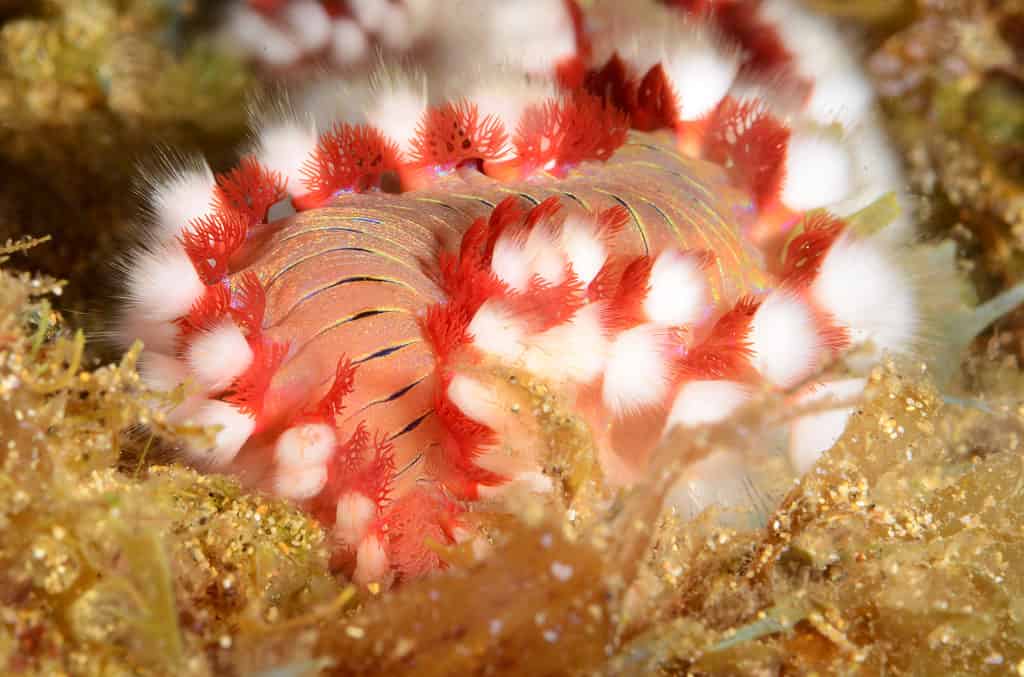Bearded Fireworm
Hermodice carunculata
They emit bioluminescence during their mating ritual.
Advertisement
Bearded Fireworm Scientific Classification
- Kingdom
- Animalia
- Phylum
- Annelida
- Class
- Polychaeta
- Order
- Aciculata
- Family
- Amphinomidae
- Genus
- Hermodice
- Scientific Name
- Hermodice carunculata
Read our Complete Guide to Classification of Animals.
Bearded Fireworm Conservation Status
Bearded Fireworm Facts
- Prey
- Coral, anemones, small crustaceans
- Main Prey
- Coral
- Fun Fact
- They emit bioluminescence during their mating ritual.
- Most Distinctive Feature
- White bristles
- Distinctive Feature
- red and orange colors
- Habitat
- Coral reefs, rocky areas, seagrass, muddy bottoms
- Predators
- White grunts, sand tilefish
- Diet
- Carnivore
- Favorite Food
- Coral
- Type
- Marine worm
- Common Name
- Bearded fireworm
- Special Features
- Venom-filled bristles
- Location
- Atlantic Ocean, Mediterranean Sea
View all of the Bearded Fireworm images!
“Each body segment of the bearded fireworm has hollow venom-filled bristles, which break off after penetrating flesh.”
Summary
The bearded fireworm (Hermodice carunculata) is a flat, segmented bristle worm that lives in the tropical waters of the Atlantic Ocean and the Mediterranean Sea. You can find them resting under stones in rocky areas or seagrass or feeding on corals near the water’s surface. These worms are venomous and produce a powerful neurotoxin that can debilitate their predators and cause adverse reactions in humans. Discover everything there is to know about the bearded fireworm, including where it lives, what it eats, and how it threatens a sensitive marine species.
5 Amazing Bearded Fireworm Facts
- People who accidentally brush past a bearded fireworm can exhibit symptoms like irritation, burning, nausea, and dizziness. You can remove the spines by covering them with adhesive tape.
- They emit bioluminescence during their mating ritual.
- The bearded fireworm is a distinctive creature featuring colorful segmented bodies and white silks.
- The white bristles that protrude from their bodies are hollow and filled with venom.
- They remove the tissue from the coral, leaving them exposed to algae and disease.
Classification and Scientific Name
The bearded fireworm (Hermodice carunculata) belongs to the Annelida phylum (segmented worms) in the Polychaeta class, which encompasses marine worms known as bristle worms. Their Aciculata order is a subspecies of bristle worm found in aquatic environments and brackish water. The Amphinomidae family comprises the marine polychaetes, with many species featuring stiff bristles mineralized with carbonate. And lastly, they belong to the Hermodice genus, a group of annelids with a cosmopolitan distribution.
Appearance

Each body segment has hollow white bristles filled with venom.
©Alexandre Ornellas/Shutterstock.com
Bearded fireworms are flattened segmented worms with an average length of 6 inches. But they can grow as large as 12 inches. Their coloring varies and can range from yellow to red, green, and white. They look similar to a centipede and feature white silks, lateral body protrusions (parapodia), and red or orange gills on the side of their body. Each body segment (there are between 60 to 150) has hollow white bristles filled with venom, which break off after penetrating flesh. They also feature small growths called caruncles on the anterior portion that are also red or orange, like the gills.
These worms get their name from the burning sensation they produce in their victims upon contact with their bristles. These bristles flare out when they are disrupted, so they are further exposed. While their toxin is effective in debilitating their marine predators, they are relatively harmless to humans. However, coming in contact with their neurotoxin can produce extreme irritation and a painful burning sensation around the injection site.
Distribution, Population, and Habitat
It is native to the tropical waters of the Atlantic Ocean and the Mediterranean Sea, primarily around the coasts, from Algeria to Liberia and along the United States’ southeast coast down to South America’s northern tip. You can also find them in the Gulf of Mexico and the Caribbean Sea. They live on reefs, rocky areas, seagrass, and muddy bottoms. Look for them under stones or resting on top of reef beds in shallow water near the surface and as deep as 130 feet.
Evolution and History
The first polychaetes date back 505 million years ago, during the Cambrian Period. Their ancestors also featured feather-like bristles and sensory tentacles attached to their heads. But what’s truly fascinating is that these creatures survived five mass extinctions, making way for the abundance of marine worms that exist today.
Predators and Prey
Bearded fireworms are marine predators that eat coral (hard and soft), small crustaceans, and anemones. They place coral tips into their inflated pharynx and remove the tissue, spending around five minutes at each branch. This species can be quite damaging, feeding on endangered coral and exposing them to disease. Fireworms prefer to prey on corals but they will also consume squid, krill, shrimp, clam, and mussels in captivity. Most marine creatures ignore these worms, but several species, like white grunts and sand tilefish, feast on bearded fireworms when encountered.
Reproduction and Lifespan
The bearded fireworm can reproduce through asexual and sexual means. They can undergo fragmentation, where their bodies divide into separate parts and regenerate to become new individuals. But they can also reproduce through regular spawning, which typically occurs two to five days after a full moon. Females emit a phosphorescent glow, attracting males to the surface, where they flash their colors, as well. As they move toward each other, they shed and combine their sex cells. They live for an average of two to three years.
Threats and Conservation Status
The conservation status of the bearded fireworm is not listed in the International Union for Conservation of Nature database. Their status and population size are unknown. Not enough research has been conducted on this species to know what threatens them. However, bearded fireworms are a known threat to coral reef systems in their range.
Locations:
- Atlantic Ocean
- Mediterranean Sea
- Gulf of Mexico
- Caribbean Sea
Related Animals
View all 285 animals that start with BBearded Fireworm FAQs (Frequently Asked Questions)
Is the bearded fireworm poisonous?
The bearded fireworm is venomous. They produce a neurotoxin that they release from hair-like bristles to defend themselves. Humans can occasionally be injected with their venom, as well.
What to do if you touch a fireworm?
Their stings can be painful and cause a burning sensation, nausea, and vomiting. The best way to handle these symptoms is to use an over-the-counter pain reliever and place adhesive tape over the injected spines to remove them. But you should always consult a physician for the best course of action.
Where does the bearded fireworm live?
The fireworm lives in tropical waters in the Atlantic Ocean and the Mediterranean Sea. You can find them on coral and underneath stones near grassy, rocky, or muddy bottoms.
What eats bearded fireworm?
Most marine animals ignore the bearded fireworm. But some fish species, like sand tilefish, will quickly consume them if encountered.
How big do fireworms get?
The average fireworm reaches 6 inches long. But these worms can grow up to 12 inches.
Why do fireworms glow?
Females produce bioluminescence during reproduction to attract males. The glow comes from a bluish-green mucous as she releases her gametes into the water.
Why are they called fireworms?
They received their name from the burning sensation they leave after injecting their neurotoxin into humans.
Thank you for reading! Have some feedback for us? Contact the AZ Animals editorial team.
Sources
- Lamar.edu, Available here: https://www.lamar.edu/arts-sciences/biology/study-abroad-belize/marine-critters/marine-critters-2/fireworm.html
- ESA Journals, Available here: https://esajournals.onlinelibrary.wiley.com/doi/10.1002/fee.1305#:~:text=Beneath%20many%20of%20the%20platforms,Figure%201%20and%20WebVideo%201
- Smithsonian Magazine, Available here: https://www.smithsonianmag.com/science-nature/14-fun-facts-about-marine-bristle-worms-180955773/
- NCBI, Available here: https://www.ncbi.nlm.nih.gov/pmc/articles/PMC5778601/
- T and F online, Available here: https://www.tandfonline.com/doi/abs/10.1080/10236244.2018.1502031?cookieSet=1

















